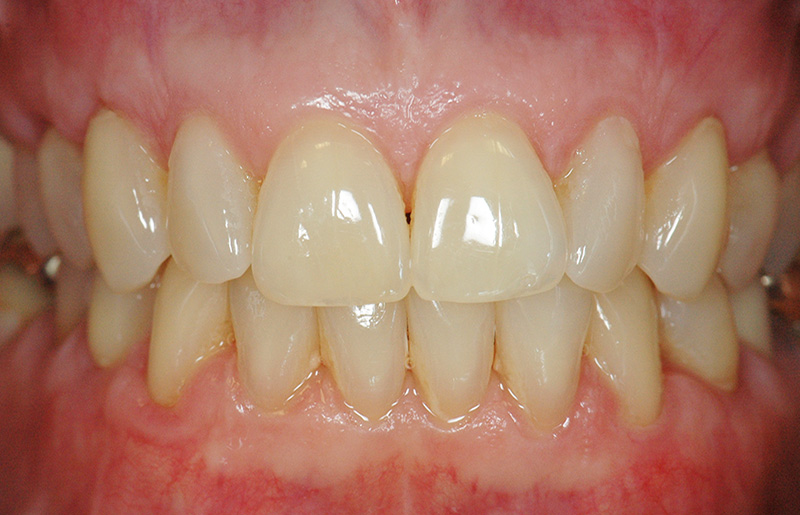A Comprehensive Guide to Gum Grafting
I am confident this is the most comprehensive guide you will find on the internet regarding gum grafting.
In this guide, I will share with you my knowledge, life-changing stories, and experiences around gum graft treatment.
My name is Dr. Kamran Haghighat, B.D.S., M.S., P.C., and owner of Portland Perio Implant Center --- which is a leading periodontal center in Portland.
So if you're searching to learn as much as you can about gum grafting, I hope that you will find value in this guide.
DR. KAMRAN HAGHIGHAT
B.D.S., M.S., P.C.
Diplomate, American Board of Periodontology
Diplomate, American Board of Oral Implantology
Fellow, International Team for Implantology
Contents
Chapter 4
What To Know After Your Gum Graft
Chapter 5
PRF for Gum Grafting
Chapter 6
Gum Grafting for Dental Implants
CHAPTER 1
What Is A Gum Graft Procedure?
So your dentist or periodontist has informed you that you might need a gum graft. While that might sound dreadful, there’s nothing to be apprehensive about. A gum graft may be the solution that prevents further damage and deterioration to your gums and provide support for your teeth affected by gum erosion or underlying periodontal disease.
An autogenous gum graft is performed by moving some tissue from the roof of the mouth to a part of your mouth where gums have receded or have been damaged by disease or iatrogenic reasons such as aggressive brushing. In doing so, the goal is to stimulate new gum growth to repair damage and to cover and protect dental roots that have become exposed.
Most gum graft procedures primarily aim to correct and reverse gum recession. However, sometimes gum grafts are used for thickening of the existing tissue (thin tissue biotype) or for pre-prosthetic reasons. One in 10 adults has some degree of gum recession. When gum recession becomes severe, dental roots can be exposed to bacteria as well as external abrasive forces that can lead to wear. In rare cases of severe gum recession with underlying bone loss, tooth loss may ensue due to loss of protective mechanical and biological support.
adults has some form of gum recession.
Let's look at what you can expect during a gum graft procedure, including your post-treatment recovery period.
What Happens During A Gum Tissue Graft Procedure?
Types of Gum Grafts A Periodontist Might Recommend
Autogenous connective-tissue graft
Free gingival graft
Pedicle graft
Allogeneic graft (donor tissue)
Stem cell based biological grafts including L-PRF
Advantages and Disadvantages for Each Type of Gum Graft
Each type of graft has its advantages and disadvantages. The type of grafting proposed will depend on the goal of therapy, the status of your mucogingival condition and presentation, the number and distribution of affected sites, and availability of tissue volume amongst other factors such as preference for self vs donor tissue.
Autogenous connective-tissue grafts are widely considered as the gold standard method used to treat thin, damaged, or receded gums. The procedure derives its name from subepithelial connective tissue which is the tissue that lies underneath the surface layer of the patients' roof of the mouth. Once this donor tissue is removed, the small incision line used for tissue harvest is sutured. This tissue is then transplanted in the area being treated and after a short healing period will result in correction of the recession as well as thickening of the thin vulnerable gum tissue. This is the most common use of autologous soft tissue in root recession coverage procedures especially so in the esthetically demanding areas.
Free gingival grafts today have limited application and are not often proposed. Tissue from the surface layer of the roof of the mouth is used; the donor tissues are taken directly from one part of the mouth and grafted onto another part of the mouth. For the most part, this approach is used for patients with thinning gums without the aim of root recession coverage or patients who need pre-prosthetic procedures such as increasing the depth of the vestibule.
Finally, patients who are blessed with naturally thicker gums may be eligible for so-called pedicle grafts. This type of gum graft procedure involves the mobilization of a gum flap right next to the area requiring treatment. The flap of gum tissue is then stretched over the affected area, covering any exposed dental roots. This procedure can also be combined with a connective tissue graft.
During the gum grafting procedure, the periodontist may also utilize special regenerative techniques including the addition of growth-stimulating proteins, PRF Regeneration (platelet-rich fibrin), or the placement of regenerative matrices into the wound. The goal is to jumpstart and accelerate the body’s natural healing capabilities.
What Happens During The Gum Graft Recovery Period?
Immediately following a gum graft procedure patients can return home, and with the exception of eating precautions, can resume normal daily activity. However, you’ll most likely want to arrange for a friend or family member to help get you home safely, and to rest, if the procedure was performed with sedation.
Depending on the type and extent of gum graft procedure being performed, sedation, in addition to local anesthesia may be suggested. Sedation can be offered in oral or IV forms, and this will be determined on a patient-to-patient basis.
Postoperative care following a gum grafting procedure is relatively straightforward. Avoid touching the part of the gums that received the grafts. That means avoid brushing and flossing the sensitive and fragile areas that have received treatment. Your periodontist will likely provide a unique, postoperative mouthwash designed to control bacteria, plaque, and other unwanted microbes to prevent infections and promote healing.
The surgical area will often be sore for a few days following the operation. To avoid damaging the part of the gums that is recovering, patients will often be told to eat a soft diet of cool foods that won’t irritate the surgical wound. Foods such as soft eggs, soft pasta, soft vegetables, and other soft foods that do not require much chewing are generally recommended for the initial week or so following a gum graft procedure. It is also recommended that patients avoid strenuous exercise in the initial phase of healing to avoid elevation of blood pressure that may cause minor bleeds and increase the swelling.
Patients who received the graft tissue material from a tissue bank, for example, should anticipate less discomfort as a second surgical site (roof of mouth) is not involved. Patients who derive their source tissue material from the top of their mouths will likely experience slight ache in the area for a few days and require a slightly longer recovery period.
While complete healing can take a few weeks, most patients go right back to work the following day. Some patients may find speaking, and enunciation, in particular, a little awkward, but most gum graft patients can get back into the swing of things within two to three days.
Potential Post Gum Graft Surgery Complications
While gum graft procedures are common and typically do not lead to complications, patients should be aware of the signs of potential complications from gum graft surgery.
Potential Gum Graft Procedure Symptoms
Extreme pain that gets worse over time
Escessive swelling or bruising (depending on extent of the graft)
Pus or effluent
Rancid taste in the mouth
Persistent bleeding despite applying pressure over a period of time
If something is atypical or out of place healthwise, or you are experiencing any of the above symptoms, call your periodontist for an assessment.
CHAPTER 2
What to Know BEFORE Your Gum Graft Procedure
A gum graft procedure can be intimidating at first. However, with new minimally invasive techniques employed today, this routine procedure is quick to perform and relatively pain free. It involves moving tissue either from the Palate or use of artificial and external sources of tissue to where it's needed for replacing receded, damaged or diseased gum tissue.
In cases where the use of donor tissue is an option, this eliminates the need to remove any tissue from the roof of the mouth.
Knowing the procedures for a gum graft and what to expect can help ease the anxiety that many patients may have about the surgical procedure.
To that effect, the following is a quick summary of some of the essential things you should know before, during, and after a gum graft procedure.
What To Know BEFORE Your Gum Graft
Like any surgical procedure, the BEFORE portion of a gum graft procedure is just as significant as the actual procedure itself or the recovery period that follows. Proper preparation ensures not only a smooth surgery but can help doctors and patients alike avoid potentially Complications.
Here’s what you need to know about gum grafts before your surgery.
1. Know the three types of gum grafts.
There are three different types of gum grafts. While each type of grafting procedure involves the placement of tissue onto an area where dental roots have been exposed, the methods by which that tissue is obtained differs.
The three types of gum grafts are connective-tissue grafts (subepithelial), free gingival grafts, and allogeneic grafts.
Each type of grafting technique has its advantages, disadvantages, and ideal-use cases. Your periodontist will discuss these with you in detail during your consultation so an informed decision is made.
As a general overview, connective-tissue grafts involve the removal of subepithelial tissues from the palate of the mouth. An incision is made to access this tissue which resides beneath the surface. The incision is then closed with fine sutures and the harvested graft is transferred and secured onto the gum recession sites.
Free gingival grafts, although infrequently used today, involves the removal of the surface tissue from the palate. The area is left to heal naturally and a typically a removable protective cover is provided to aid in patient comfort during this period.
The pedicle graft is mobilization of the adjacent tissues to the recession to cover the roots and is often combines with a connective tissue graft.
2. It's possible to use donor tissues and not your own.
Sometimes it’s just not possible to source adequate quantity of graft tissue from the patient. For example, if a patient displays severe and generalized gum recession throughout the mouth in multiple sites, it would not be possible to source all the graftable tissue required to cover all the recession defects from the patient’s palate. That’s when patients and doctors turn to donor tissue material.
While it might sound strange, tissues derived from a human donor are quite useful in a gum graft application. Since 1997, proprietary AlloDerm Regenerative Acellular Dermal Matrix has been widely used (with over 2.5 million grafts applied) in treatment of gum recession with comparable success to self tissue.
3. Get a designated driver.
Should you opt for additional anti-anxiety sedation for your surgery, it is necessary to arrange for a friend or family member to come pick you up and get you home safely. Patients are required not to operate any machinery for 24-hours. Talk to your periodontist more about sedation and anesthesia options if needed. If sedation is not employed, patients can leave the office after the procedure without an escort.
It is important to note that sedation is not the same as general anesthesia. In a gum graft procedure, local anesthesia (aka “novacaine”), will be used to numb the areas. The use of Sedatives as an anti-anxiety medication are typically taken in pill form or through an IV drip and are used to help patients relax. Sedatives allow patients to remain conscious, aware, and able to respond to stimuli while avoiding “dental anxiety,” undue stress, and nervous fidgeting. They also produce retrograde amnesia so you may not remember everything about the procedure despite not being unconscious. So essentially makes this a much safer method than general anesthesia.
CHAPTER 3
What to Know DURING Your Gum Graft Procedure
What To Know DURING Your Gum Graft
You're ready to get a gum graft, and you’re now sitting in the periodontist's chair. Following is what you can expect DURING your gum graft procedure.
1. Numbness prior to your gum graft surgery.
During your gum graft surgery, you’ll probably be awake like most people, or perhaps opt to be sedated. Most patients do not require anything more than local anesthetics to numb the area. Once the area is numb you will only feel slight applied pressure but will not feel pain or sharpness.
Local anesthesia is administered with the use of a syringe. This is made more comfortable by applying some topical anesthetic in the injection sites first to minimize the sensation of the needle. With general anesthesia, the patient is unconscious. For gum graft surgery, general anesthesia is unnecessary as the risks outweigh the benefits. However, patients who have dental anxiety can request sedation dentistry.
Sedatives don’t work in the same way local anesthetics do and are used as an adjunct to them. They do not provide numbness. Instead, sedatives help patients feel calmer without affecting their ability to respond to stimuli. Sedation dentistry can be provided either by oral or intravenous administration. If you choose to be sedated, this is done prior to administration of local anesthetic. Additional time will be allocated for sedation dentistry to take effect prior to proceeding with local anesthetic and the procedure.
You should consider requesting sedatives if:
You have anxiety
You have uncontrollable movements
You have strong gag reflexes
2. Bring your own distraction device.
Patients should expect a gum graft procedure to take around an hour to complete, depending on the extent of case. For most patients that opt to be awake during the process, as a form of distraction, you may listen to music while the procedure is taking place so bring a headphone along. Listening to a podcast or music is a great way to distract yourself from the poking and prodding going on in your mouth, even though there is no pain. At the very least, music can provide a level of calmness and help reduce anxiety.
CHAPTER 4
What to Know AFTER Your Gum Graft Procedure
Your gum graft experience isn't over when you're out of surgery. The recovery period will require more effort, care, and attention to your mouth and gums on your part than any other stage in the gum grafting process. Following the necessary post-operative instructions will ensure optimal outcomes.
Following are some things you should know about the recovery period AFTER your gum surgery.
1. Watch what you eat.
The recovery period is intended to give your gums time to heal. More importantly, this period of time allows the graft tissue to become integrated into the host tissues of the gums and attach to the teeth and periodontium.
Trauma to the graft tissues or excessive movement could delay the healing process. Although the graft is secures in place, excessive pressure and movement in the area may result in slower or suboptimal healing and root coverage. This can be avoided by enjoying softer food during the initial healing period to allow attachment of the graft to the host tissues.
Part of allowing the site of the graft to fully heal means watching what you eat. Your periodontist will likely recommend soft palatable foods while the gums are healing to minimize irritation to the surgical sites.
2. Give your gum graft time to heal.
It’s important not to rush the healing and recovery process. For the gum graft process to be successful, the graft must be allowed to not only fully integrate into the surrounding soft tissues and tooth surface. This is a process may take 6 weeks to reach a stable stage, however, the initial three weeks is considered as the critical period and the diet is altered after this time. Three weeks also coincide with when the sutures are removed.
New capillaries must be formed by your body to bring nutrients to the site of the graft. New tissues must be allowed to grow. Depending on the size and extent of the graft, this is a process that could take a few weeks or longer. The dietary restrictions make most patients to opt for all the recession defects to be treated in one procedure. This does not increase the healing phase but allows the foodies amongst us to have restrictions only once.
Patients who choose to have the conventional method of graft tissue harvested from their palate will also have to contend with wound healing of this secondary area. Typically, after surgery, the doctor may apply a piece of dissolvable gauze or a removable protective cover for the palate that improves comfort and healing.
3. Sutures that need removal versus those that resorb.
While the actual gum grafting procedure takes place during a single visit, patients will also need to make additional in-office follow-up visits so the periodontist can monitor the healing progress. Patients are requested to be seen after one week following post surgery for a brief check, to make sure the site is healing uneventfully.
The type of suture material used varies between case types. Some are dissolvable at 7-10 days, while others require removal. The type of suture used will be determined based of the case type. In the event of non-resorbable sutures, removal is typically done at 3weeks post-operatively. A final healing evaluation is normally done after 3-6 months to ensure the treatment goal has been met.



































